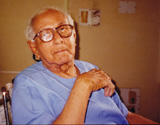Notes on counselling
Conscious perfection — dignity of the inner being
Abstract
The perfect archetypal representation of each idea in the global cognitive field facilitates a progressive movement towards perfection. In the process, the pursuit of perfection through the cultivation of virtues becomes a sort of personal aasana in one’s spiritual sojourn.
Perfection in all our activities, movements, gestures has been a eulogised mark of culture, an expression of finesse and a goal of civilisation. Nobody contests its utility, for both the yogi and the scientist strive for it with equal zeal. The Mother adds another dimension when she stresses that every effort towards perfection has to be ‘conscious’. Even in each physical activity, it is not the mechanical technique but the consciousness infused that brings the result: “This amounts to saying that it is the conscious will which acts on matter, not the material fact (1).” Every act of perfection has to be executed consciously, with full awareness and with an investiture of appropriate energy, aspiration and goodwill.
The very moment every act of perfection is infused with consciousness, another dimension opens up. Perfection no longer remains static, it becomes dynamic and progressive. What is perfect at one point of time may not hold its fort at another point; what is perfect today may not be perfect tomorrow. If something has been done perfectly now, it has to be repeated with a new denouement of perfection later. Perfection is an ever-progressive attempt to get to the Truth.
One might say, especially in the milieu of the psychiatric clinic, that the perfectionist trait has its pathological perspective too. After all, the individual with obsessive compulsive personality harbours perfectionist traits while someone with an obsessive compulsive disorder strives and suffers continually in the labyrinthine alleys of repetitive attempts to counter a perceived imperfection.
There is however an important qualitative difference in the striving for perfection as part of personal growth and the ruminations of fighting against imperfection in the obsessive compulsive subject. The obsessive compulsive subject suffers from pathological anxiety, exaggerated guilt, frustration and morbid depression. The seeker of personal growth is free, detached and without any anxiety. While the obsessive subject struggles against an imperfection constructed in the mind, the seeker of personal growth attempts perfection with joy, spontaneity and freedom. While the obsessive subject gets more and more stressed, anxious and exasperated with every fight against imperfection, the seeker of Truth gets progressively free from stress with every conscious attempt at perfection that brings one nearer and nearer to the Truth.
The Mother described how every small movement could be executed with a conscious perfection. Sri Anirvan , the great wayfarer saint, expands on The Mother’s insistence for perfection. He describes that every conscious act of perfection can be construed in two ways:
a. Each movement could be a ‘personal asana’ in one’s own spiritual pursuit; or
b. Each conscious gesture could be a voluntary movement connected with one’s most conducive spiritual poise.
In either case, each conscious attempt at perfection would reflect the dignity of the inner being (2).
Why perfection?
The anarchist would question the necessity to strive for perfection. After all, imperfection is a reality and part of life, so why deny it? A rational answer is difficult. One can venture to seek its reason in the Aurobindonian paradigm. The Supreme Creative Supramental Consciousness holds the ‘idea’ of each form while the Overmind plane of Global cognition manifests each ‘idea’ as a perfect archetype that would be replicated in the world bound by space and time. However, during the process of replication, the archetype suffers distortion and deviation when ultimately manifested in the earth consciousness. The redemption comes by a continual process of progressive perfection striving towards the Truth. The perfect archetype in the global cognitive field exerts its pull in creation.
Amal Kiran (K.D.Sethna) explains how in one of his most moving poems, Sri Aurobindo describes the archetypal representation that is ever-perfect (the first two lines of each stanza) and the aspiration invoking its blossoming in the earth-consciousness (the last two lines of each stanza) (3):
“Rose of God, damask force of Infinity, red icon of might,
Rose of Power with thy diamond halo piercing the night!
Ablaze in the will of the mortal, design the wonder of thy plan,
Image of immortality, outbreak of the Godhead in man (4).”
If the Unconscious (in Freudian terms) influences each piece of behaviour, the Superconscious equally pulls up each piece of behaviour towards its heavenly archetypal representation. This is the raison d’être for the quest for progressive perfection.
Attributes of perfection
Perfection is a eulogised state needing the cultivation of certain attributes. The Mother, while describing psychological and spiritual significances of flowers, named Plumeria rubra to represent Psychological Perfection. This tree bears clusters of fragrant funneliform flowers with soft velvety petals in a large variety of colour combinations. The Mother explains:
“There is not one psychological perfection but five. They are sincerity, faith, devotion, aspiration and surrender”. She elaborates, “Such qualities as faith, sincerity, aspiration, devotion, etc. make up the perfection indicated in our language of the flowers. In ordinary language it would mean something else such as purity, love, benevolence, fidelity and a host of other virtues (5).”
The pursuit of perfection automatically implies a cultivation of a host of virtues.
References
1. The Mother. Collected Works of the Mother, Volume 9. Cent. ed. Pondicherry: Sri Aurobindo Ashram Trust; 1977, p. 154.
2. Lizelle R. To Live Within. The story of five years with a Himalayan guru. UK: George Allen &Unwin; 1972, p. 160.
3. Sethna KD. Sri Aurobindo –The Poet: Rose of God: A Comment on its Mysticism and its Poetry. Pondicherry: SAICE; 1970, pp. 264-88.
4. Sri Aurobindo. Complete Works of Sri Aurobindo, Volume 2. Pondicherry: Sri Aurobindo Ashram Trust; 2009, p. 564.
5. The Mother; Flowers and Their Messages. 4th ed. Pondicherry: Sri Aurobindo Ashram Trust; 1992, p. 196.
Dr. Soumitra Basu, a practising psychiatrist and member of SAIIIHR, is the Director of a school of psychology, Integral Yoga Psychology. He is also one of the editors of NAMAH.
Share with us (Comments,contributions,opinions)
When reproducing this feature, please credit NAMAH,and give the byline. Please send us cuttings.




